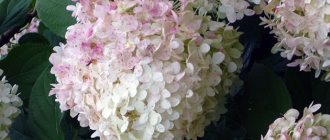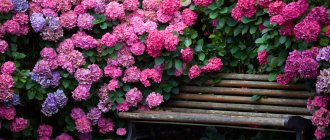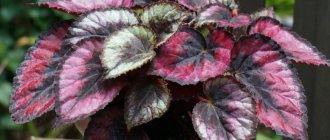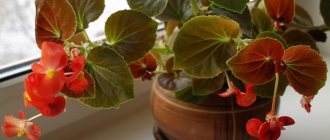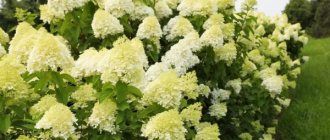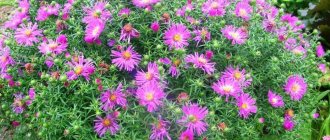Modern breeders have developed many beautiful varieties of hydrangea. Its lush bushes attract with their beauty, grace, delicacy of shape and luxury. This type of ornamental shrub is valued by flower growers due to its long flowering period, ease of care, and variety of varieties. Many gardeners who grow hydrangea as a tree are interested in what it is called in common parlance? In hospitable Japan, the perennial is called audjisai. He is considered a master of transformation, because the final color of the inflorescences depends on the level of acidity of the soil.
Garden hydrangea can delight its owner with abundant flowering for a long time if it has been provided with proper care. First, you need to determine a comfortable place to plant it. A correctly selected planting site is the main condition for comfortable development and its unsurpassed appearance.
Description of the plant
Hydrangeas are shrubs or small trees, the delicate inflorescences of which consist of large flowers with four sepals, similar to petals. The foliage shape of the unpretentious hydrangea is ovoid.
Hydrangea varieties
The wild variety is found in its natural range in South and East Asia, and a wide variety of species can be found in China and Japan. Among the varieties there are multi-stemmed shrubs and low trees that prefer to grow in shaded areas and do not tolerate drought.
Popular species include red tree hydrangea, which grows wild in North America. This shrub is capable of growing up to 3 m in height. The large-leaved variety produces inflorescences in the form of a large shield with a diameter of up to 15 cm. The unpretentious winter-hardy tree hydrangea has a rapid growth rate.
Chereshkova
This is an unusual hydrangea - not a bush, but a perennial vine, characterized by increased decorativeness. In the wild, its length can exceed 25 meters, but at home it rarely grows to 3 meters.
It is attached to the surface using aerial roots. It is distinguished by pale rounded leaves. The flowers are greenish-white or pink, and may be light lavender. Collected in an inflorescence with a diameter of 15-27 cm.
Flowering occurs in the second half of summer and ends with the arrival of autumn frosts. The variety tolerates midland winters well, but in more northern latitudes it can freeze.
Despite its unpretentiousness, it is quite rare in areas. The reason is its unusual form. There are two methods for propagation: cuttings and seeds.
Climbing petiolate hydrangea will help tastefully decorate the appearance of country houses and gazebos
Types of hydrangeas in the world
Hydrangea paniculata - the best varieties for the Moscow region
Experienced breeders note the following varieties of perennials that have earned recognition around the world:
- Hydrangea paniculata is the most adapted to the harsh conditions of the middle zone;
- The tree-like variety is a compact shrub, unpretentious in care, it is not afraid of light frosts and the lack of direct sunlight;
- This garden or large-leaved beauty comes from hospitable Japan; it can also be found on Sakhalin Island. A fairly heat-loving species, it requires shelter for fragile roots during the wintering period.
Reproduction
- by cuttings - green branches are cut from the crown at an angle of 90 degrees, placed in a previously prepared fertile extract and waiting for the roots, then placed in a greenhouse in special beds for growing the bush and kept for about 2 years;
- by division - the hydrangea is dug up and divided into several shrubs so that at least one bud must be present in each division, then planted in prepared areas;
- layering - young shoots no older than a year are bent to the soil and dug in, leaving a 20 cm long shoot at the top, and the following spring the rooted shoot is torn off and replanted;
- seeds and grafting - they practically do not reproduce!
Varieties of unpretentious hydrangeas for shady places
Hydrangea Bobo - a dwarf variety of paniculate winter-hardy hydrangea
Experienced flower growers distinguish some types and varieties of hydrangea, which can rightfully be classified as unpretentious, resilient and frost-resistant perennials, characterized by lush flowering and decorativeness.
Which hydrangea is the most unpretentious of all common varieties? The most widespread is an unassuming tree-like variety with large oval leaves, light green on top and bluish on the bottom. From June to September, the lush bush is framed by delicate inflorescences with a diameter of 15 cm. In the natural conditions of Moscow and the Moscow region, the beautiful perennial grows and develops successfully without the need for additional shelter for the winter, and is able to bloom profusely even in partial shade.
The easiest to care for is Grandiflora. The variety is distinguished by its strong growth, abundant and long-lasting flowering, and beautiful wide-pyramidal inflorescences. Over time, it grows into a tall, spreading shrub. The peak of the decorativeness of the species occurs from June to September. The variety blooms with large creamy white inflorescences. This variety has one drawback: thin branches can break under the weight of the support, so they require additional support.
Endless Samme
Endless Summer is a large-leaved variety that deserves the attention of experienced gardeners. It is able to bloom on both new and regrown shoots. This dignity of the species is extremely important for Central Russia. Even in the event of another freezing, a lush bush in favorable external conditions can delight with fragrant flowering.
Due to the unique ability to form beautiful buds several times during the active growing season, the unassuming variety was called “Endless Summer”. The sterile flowers can vary in color from bright pink to blue, depending on the acidity level of the soil. The species attracts attention because there are inflorescences of different colors on one plant. The striking inflorescences are good for drying; they are used to form original ikebana flowers with a subtle honey aroma. Despite the high frost resistance, in the harsh conditions of the middle zone it is recommended to mulch and cover the bushes with a special non-woven material.
The oakleaf perennial is ideal for shady places, since the daily presence of sunlight does not affect the decorative qualities of the species; this point is also indicated in the description of the plant. The perennial is also characterized by increased resistance to cold. Experienced flower growers advise keeping it in a spacious pot for the first year of its life, then only planting it in the ground.
Disease prevention and pest protection
When all conditions are created for hydrangia on the site, it rarely gets sick. If light yellow spots suddenly appear on the plant, it means that chlorosis is developing. In this case, water the plant with a solution of potassium nitrate at a concentration of 4 g per 1 liter of water. After three days, do the same prophylaxis with a solution of ferrous sulfate in the same ratios. If dark oily spots appear on the foliage and stems, then the shrub is infected with downy mildew.
This happens with excessive humidity and increased heat conditions. The best way to combat this disease is with a copper-soap solution. To prepare it, take 15 g of copper sulfate and 150 g of green soap (contact insecticide) in a bucket of water. In summer, with high air humidity, gray rot may develop. Treat the affected leaves and stems with fungicides: “Skor”, “Topaz”, “Fitosporin-B”. When air humidity is low, bushes are attacked by spider mites and aphids. Treat them with soapy water.
Did you know? The Japanese associate the appearance of the most beautiful flower “aujisai” with the ascent of the little Buddha to earth. This was the hydrangea.
Preventative work to get rid of pests will be the removal of weeds where they breed . All hydrangea varieties listed in the article can withstand not only cold winters, but also polluted air. The right place for planting and proper care will give hydrangia long-lasting fragrant flowering even in regions with a harsh climate. Get yourself a few hardy varieties and delve into the world of amazing hydrangeas.
New hybrid varieties of low hydrangeas
When choosing a blooming beauty for your site, flower growers should pay attention to the following compact varieties of hybrid hydrangea of small height:
- Compact type "Limelight" with strong thick shoots that do not fall apart under the weight of the inflorescences. Blooms profusely from August to October with sterile white-green conical inflorescences, which then turn pink;
- The new variety “SilverDollar” - a compact bush 2 m in height attracts attention with the unusual shape of the bush, wide crown, and vertical shoots. In July, it is completely covered with pyramidal inflorescences, which begin to turn pink by autumn;
- “DiamantRouge” is a variety of red hydrangea, no more than 1.3 m high. It blooms profusely with white flowers in inflorescences, then they quickly turn red. The eye-catching color remains throughout the entire flowering period; external weather conditions do not affect this.
Landing
Hydrangeas are usually planted in open ground or in groups on lawns in early spring or fall. In cold climates, it is better to plant by cuttings in the spring next winter, so the plant can better withstand the cold. First, a hole is prepared, peat and fertilizers are added to it, then the roots are shortened and the plant is planted. The hole should be approximately 30 cm, and the distance between each future or already developed bush to be planted should be at least 1 m. The shoots are pruned into several buds, the planted bush is wrapped in humus at the base and watered abundantly.
How to determine the type and variety of hydrangea
How to determine whether this is a tree that looks like a hydrangea, or a really lushly blooming beauty? You can identify a particular variety by the shape of the leaves. For example, the paniculate variety has long and hard leaves of an elliptical shape, the leaf plate of the hydrangea is tree-shaped, large, ovoid in shape with a heart-shaped notch at the base, there is also a narrow-leaved variety - rough hydrangea, its leaf shape has a serrated edge, strongly bent back.
Advice. You can also identify a particular variety by its inflorescences. Varietal hydrangea and paniculata are covered with white caps of inflorescences; in the large-leaved beauty they can be pink, blue, or crimson. The paniculate species has large cone-shaped inflorescences.
Every gardener can try to grow beautiful perennials on their plot and discover the wonderful world of fragrantly flowering ornamental plants.
Rules of care
Hydrangea requires good watering (it is prone to drying out quickly), as well as loosening the soil at least 3 times during the period of growth and flowering. The depth of loosening should be about 10 or 15 cm. It should also be fed with fertilizers - ordinary humus or liquid manure.
Advice! Fertilizers should be fed in moderation, because inflorescences that develop too strongly and large can break the branches.
Mature plants need to be periodically pruned in the fall, young plants in the spring before buds appear, old bushes are cut off at the root. For the winter, hydrangea is covered.
Advice! For maximum splendor and good wintering, branches are cut to 4 buds.*
A little historical background
Large-leaved hydrangea was the first to appear in Europe. This happened at the very end of the 18th century. It was brought by French travelers from the island of Mauritius, located in the Indian Ocean. Prince of the Roman Empire K.G. was also a participant in this first round-the-world expedition for the French. Nassau-Siegen. It is believed that he named the beautiful plant in honor of his beloved sister.
Large-leaved hydrangea was born on the island of Mauritius and appeared in Europe thanks to the first French expedition around the world. It’s impossible not to notice such a beauty even in the luxurious governor’s garden
However, other sources claim that the shrub received its name in honor of the beloved of the French doctor F. Commerson. There is also a less romantic version of the appearance of this name: the bush was discovered in the governor’s garden. So they named it in honor of this event in Latin hortensis, which means “from the garden.”
Otherwise, this moisture-loving bush is called hydrantia. Translated from Greek, hydor means “water”, and angeion means “vessel”. Moreover, the point was not only that the bush needs frequent watering, but also that its seed pods look like a vessel - a jug. But the more pleasing name to the ear gradually prevailed over the Latin.

